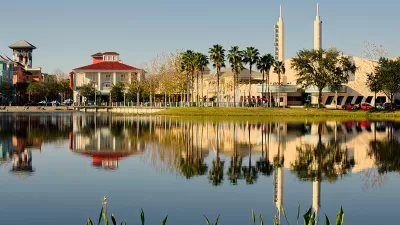Disney's efforts to make a quaint American town both failed and succeeded in ways few could have predicted.

Walt Disney's ambitions to build a perfect town were foiled in part by his death from lung cancer shortly after announcing his plan. Years later, Disney CEO, Michael Eisner, began work on what would become Celebration, Florida. "The town was developed by Disney as an antidote to the isolation of the suburbs," The Economist reports. It would be built with a sense of place at a human scale, "This community would have 20,000 residents, a central business district and futuristic public transport. Cars and lorries would be hidden away underground," continues the article..
Unfortunately, the town was unable to blossom into, "…a charming mid-Atlantic city, such as Savannah, Georgia or Charleston, South Carolina." The Economist cites a number of reasons for the town's relative level of success. In particular, the designers seem to have had different desires and interests than did the people the development attracted. The Economist notes that parks, which are no longer run by Disney, now are off limits to non-residents to the point where, "Sitting on a park bench is considered trespassing." A progressive public school designed specifically for the town did not last long there or win the hearts of the residents. "It proved a disaster. Kids slacked off. Without test scores, parents were unable to track their children’s progress." Still, with all its failings the town continues to attract homebuyers willing to pay a decided premium over the homes in the surrounding area. It seems that even with a downtown that never brought the business that the designers hoped for continues to draw residents.
FULL STORY: What Disney’s city of the future, built to look like the past, says about the present

Alabama: Trump Terminates Settlements for Black Communities Harmed By Raw Sewage
Trump deemed the landmark civil rights agreement “illegal DEI and environmental justice policy.”

Planetizen Federal Action Tracker
A weekly monitor of how Trump’s orders and actions are impacting planners and planning in America.

How Atlanta Built 7,000 Housing Units in 3 Years
The city’s comprehensive, neighborhood-focused housing strategy focuses on identifying properties and land that can be repurposed for housing and encouraging development in underserved neighborhoods.

In Both Crashes and Crime, Public Transportation is Far Safer than Driving
Contrary to popular assumptions, public transportation has far lower crash and crime rates than automobile travel. For safer communities, improve and encourage transit travel.

Report: Zoning Reforms Should Complement Nashville’s Ambitious Transit Plan
Without reform, restrictive zoning codes will limit the impact of the city’s planned transit expansion and could exclude some of the residents who depend on transit the most.

Judge Orders Release of Frozen IRA, IIJA Funding
The decision is a victory for environmental groups who charged that freezing funds for critical infrastructure and disaster response programs caused “real and irreparable harm” to communities.
Urban Design for Planners 1: Software Tools
This six-course series explores essential urban design concepts using open source software and equips planners with the tools they need to participate fully in the urban design process.
Planning for Universal Design
Learn the tools for implementing Universal Design in planning regulations.
Jessamine County Fiscal Court
Caltrans
Institute for Housing and Urban Development Studies (IHS)
City of Grandview
Harvard GSD Executive Education
Toledo-Lucas County Plan Commissions
Salt Lake City
NYU Wagner Graduate School of Public Service




























